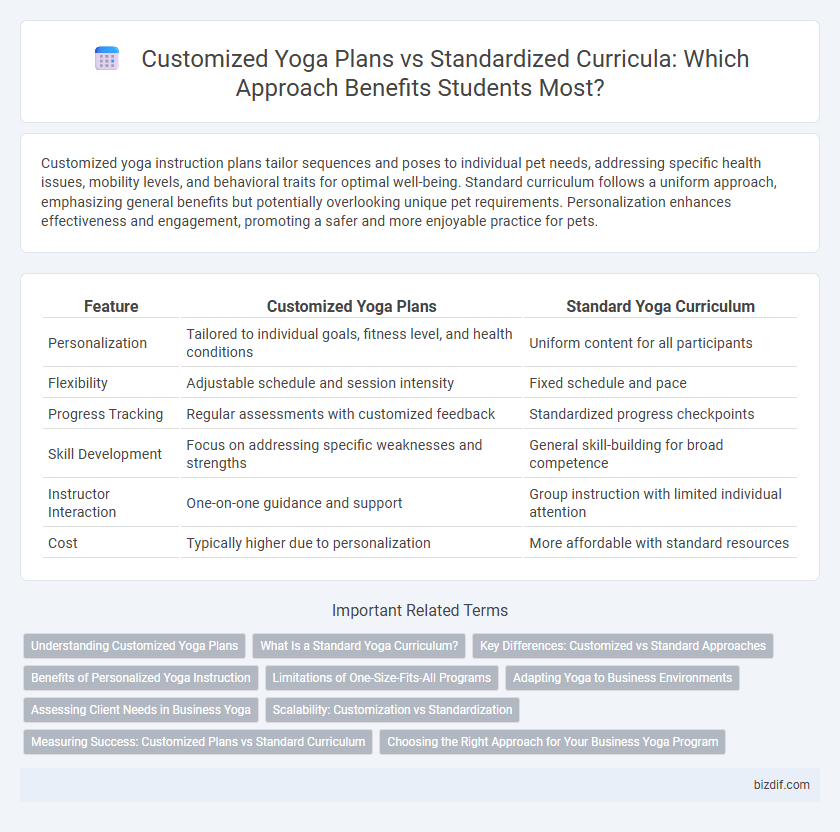Customized yoga instruction plans tailor sequences and poses to individual pet needs, addressing specific health issues, mobility levels, and behavioral traits for optimal well-being. Standard curriculum follows a uniform approach, emphasizing general benefits but potentially overlooking unique pet requirements. Personalization enhances effectiveness and engagement, promoting a safer and more enjoyable practice for pets.
Table of Comparison
| Feature | Customized Yoga Plans | Standard Yoga Curriculum |
|---|---|---|
| Personalization | Tailored to individual goals, fitness level, and health conditions | Uniform content for all participants |
| Flexibility | Adjustable schedule and session intensity | Fixed schedule and pace |
| Progress Tracking | Regular assessments with customized feedback | Standardized progress checkpoints |
| Skill Development | Focus on addressing specific weaknesses and strengths | General skill-building for broad competence |
| Instructor Interaction | One-on-one guidance and support | Group instruction with limited individual attention |
| Cost | Typically higher due to personalization | More affordable with standard resources |
Understanding Customized Yoga Plans
Customized yoga plans offer a personalized approach by tailoring poses, sequences, and intensity levels to individual needs, goals, and limitations, enhancing effectiveness and injury prevention. These plans consider specific conditions such as chronic pain, flexibility issues, or stress levels, which standard curriculums may overlook. Incorporating assessments like body alignment and breath control allows instructors to design focused routines that maximize physical and mental benefits.
What Is a Standard Yoga Curriculum?
A standard yoga curriculum offers a structured sequence of classes designed to cover foundational postures, breathing techniques, and meditation practices suitable for all skill levels. It emphasizes uniform progression through established styles like Hatha or Vinyasa, ensuring consistent teaching methods and outcomes. This approach facilitates a comprehensive understanding of yoga principles but may lack personalization for individual goals or physical limitations.
Key Differences: Customized vs Standard Approaches
Customized yoga plans tailor poses, sequences, and intensity to individual goals, body types, and health conditions, enhancing effectiveness and personal engagement. Standard curriculum follows a fixed structure often based on traditional styles, offering consistency but less flexibility for unique needs. Personalized approaches prioritize adaptive progressions and injury prevention, whereas standard methods emphasize uniform skill development.
Benefits of Personalized Yoga Instruction
Personalized yoga instruction adapts poses and sequences to individual body types, fitness levels, and wellness goals, enhancing effectiveness and reducing injury risk. Customized plans promote faster progress by addressing specific imbalances and limitations, ensuring alignment with personal health conditions. Tailored guidance fosters deeper mindfulness and motivation, resulting in a more sustainable and engaging yoga practice.
Limitations of One-Size-Fits-All Programs
One-size-fits-all yoga programs often overlook individual differences in flexibility, strength, and health conditions, leading to potential discomfort or injury. Standard curriculums can restrict progress by failing to address unique goals such as stress relief, rehabilitation, or advanced practice. Customized plans optimize alignment, breathing techniques, and pose modifications for personalized growth and safety.
Adapting Yoga to Business Environments
Customized yoga plans tailor sessions to the specific needs and culture of a business, enhancing employee well-being and productivity. These plans address unique stressors and physical demands found in various work environments, unlike the one-size-fits-all approach of standard curricula. By integrating targeted poses and mindfulness techniques, customized instruction fosters a healthier workplace atmosphere and supports long-term corporate wellness goals.
Assessing Client Needs in Business Yoga
Assessing client needs in business yoga involves evaluating individual employee health conditions, stress levels, and fitness goals to create customized plans that enhance engagement and effectiveness. Customized yoga programs address specific organizational wellness objectives, unlike standard curriculums that offer generic routines with limited adaptability. Tailoring sessions based on thorough assessments improves overall workplace productivity and reduces injury risk by aligning practices with employee capabilities.
Scalability: Customization vs Standardization
Customized yoga plans offer scalable flexibility by adapting sequences and intensity to individual needs, enhancing personal progress and retention. Standard curriculum scales efficiently for large groups with consistent content, ensuring uniformity and ease of instructor training. Balancing customization with standardization optimizes scalability by addressing diverse participant goals while maintaining operational efficiency.
Measuring Success: Customized Plans vs Standard Curriculum
Measuring success in yoga instruction varies significantly between customized plans and standard curriculums, as personalized programs track individual progress through tailored milestones aligned with specific goals, while standard curriculums rely on uniform benchmarks applied to all students. Customized plans integrate ongoing assessments such as flexibility improvement, strength gains, and stress reduction metrics to accurately reflect personal growth, contrasting with the general skill acquisition levels emphasized in traditional curricula. This individualized measurement approach enhances motivation and engagement, making customized yoga instruction more effective in achieving optimal outcomes for diverse practitioner needs.
Choosing the Right Approach for Your Business Yoga Program
Customized yoga plans cater to the specific needs, goals, and skill levels of individual clients, enhancing engagement and retention in your business yoga program. Standard curriculum offers a consistent structure ideal for large groups or corporate wellness initiatives, ensuring scalable and repeatable sessions. Evaluating client demographics and business objectives helps determine whether personalized or standardized yoga instruction maximizes impact and ROI.
Customized Plans vs Standard Curriculum Infographic

 bizdif.com
bizdif.com